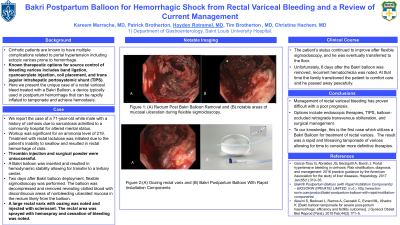Sunday Poster Session
Category: GI Bleeding
P0780 - Bakri Postpartum Balloon for Hemorrhagic Shock From Rectal Variceal Bleeding and a Review of Current Management
Sunday, October 27, 2024
3:30 PM - 7:00 PM ET
Location: Exhibit Hall E

Has Audio

Hayden E. Rotramel, MD
SSM Health St. Louis University Hospital
St. Louis, MO
Presenting Author(s)
Mohamad Kareem Marrache, MD1, Patrick Brotherton, 1, Hayden Rotramel, MD1, Tim Brotherton, MD1, Christine Hachem, MD2
1SSM Health Saint Louis University Hospital, St. Louis, MO; 2Saint Louis University Hospital, St. Louis, MO
Introduction: Cirrhotic patients are known to have multiple complications related to portal hypertension including ectopic varices prone to hemorrhage. Known therapeutic options for source control of bleeding varices includes band ligation, cyanoacrylate injection, coil placement, and trans jugular intrahepatic portosystemic shunt (TIPS). Here we present the unique case of a rectal variceal bleed treated with a Bakri Balloon, a device typically used in postpartum hemorrhage that can be rapidly inflated to tamponade and achieve hemostasis.
Case Description/Methods: We report the case of a 71-year-old white male with a history of cirrhosis due to sarcoidosis complicated by extensive portosystemic varices who was admitted to a community hospital for altered mental status. Workup was significant for an ammonia level of 219. Treatment with rectal lactulose was initiated due to the patient’s inability to swallow and resulted in rectal hemorrhage of clots. Thrombin injection and surgical powder were unsuccessful. Two units of red blood cells, one unit of fresh frozen plasma, and one unit of platelets were given. A Bakri balloon was inserted and resulted in hemodynamic stability allowing for transfer to a tertiary center. Upon arrival the patient was deemed too high risk for surgical intervention or TIPS. Two days after Bakri Balloon deployment, flexible sigmoidoscopy was performed. The Bakri balloon was decompressed and removed revealing clotted blood in the rectum and sigmoid colon. Discontinuous areas of nonbleeding ulcerated mucosa were present in the rectum likely from the balloon. A large rectal varix with oozing was noted and injected with sclerosant. The rectal area was sprayed with hemospray and cessation of bleeding was noted. The patient’s status continued to improve after flexible sigmoidoscopy, and he was transferred out of the intensive care unit. Unfortunately, 6 days after the Bakri Balloon was removed, recurrent hematochezia was noted, and the patient was transitioned to comfort care and passed away peacefully.
Discussion: Management of rectal variceal bleeding has proven difficult with a poor prognosis. Options include endoscopic therapies, TIPS, balloon-occluded retrograde transvenous obliteration, and surgical management. To our knowledge, this is the first case which utilizes a Bakri Balloon for treatment of rectal varices. The result was a rapid and lifesaving tamponade of varices allowing for time to consider more definitive therapies.

Disclosures:
Mohamad Kareem Marrache, MD1, Patrick Brotherton, 1, Hayden Rotramel, MD1, Tim Brotherton, MD1, Christine Hachem, MD2. P0780 - Bakri Postpartum Balloon for Hemorrhagic Shock From Rectal Variceal Bleeding and a Review of Current Management, ACG 2024 Annual Scientific Meeting Abstracts. Philadelphia, PA: American College of Gastroenterology.
1SSM Health Saint Louis University Hospital, St. Louis, MO; 2Saint Louis University Hospital, St. Louis, MO
Introduction: Cirrhotic patients are known to have multiple complications related to portal hypertension including ectopic varices prone to hemorrhage. Known therapeutic options for source control of bleeding varices includes band ligation, cyanoacrylate injection, coil placement, and trans jugular intrahepatic portosystemic shunt (TIPS). Here we present the unique case of a rectal variceal bleed treated with a Bakri Balloon, a device typically used in postpartum hemorrhage that can be rapidly inflated to tamponade and achieve hemostasis.
Case Description/Methods: We report the case of a 71-year-old white male with a history of cirrhosis due to sarcoidosis complicated by extensive portosystemic varices who was admitted to a community hospital for altered mental status. Workup was significant for an ammonia level of 219. Treatment with rectal lactulose was initiated due to the patient’s inability to swallow and resulted in rectal hemorrhage of clots. Thrombin injection and surgical powder were unsuccessful. Two units of red blood cells, one unit of fresh frozen plasma, and one unit of platelets were given. A Bakri balloon was inserted and resulted in hemodynamic stability allowing for transfer to a tertiary center. Upon arrival the patient was deemed too high risk for surgical intervention or TIPS. Two days after Bakri Balloon deployment, flexible sigmoidoscopy was performed. The Bakri balloon was decompressed and removed revealing clotted blood in the rectum and sigmoid colon. Discontinuous areas of nonbleeding ulcerated mucosa were present in the rectum likely from the balloon. A large rectal varix with oozing was noted and injected with sclerosant. The rectal area was sprayed with hemospray and cessation of bleeding was noted. The patient’s status continued to improve after flexible sigmoidoscopy, and he was transferred out of the intensive care unit. Unfortunately, 6 days after the Bakri Balloon was removed, recurrent hematochezia was noted, and the patient was transitioned to comfort care and passed away peacefully.
Discussion: Management of rectal variceal bleeding has proven difficult with a poor prognosis. Options include endoscopic therapies, TIPS, balloon-occluded retrograde transvenous obliteration, and surgical management. To our knowledge, this is the first case which utilizes a Bakri Balloon for treatment of rectal varices. The result was a rapid and lifesaving tamponade of varices allowing for time to consider more definitive therapies.

Figure: Figure 1: (A) Rectum Post Bakri Balloon Removal and (B) Notable Areas of Mucosal Ulceration and (C) Rectal Varix Post Sclerosing Agent Injection
Disclosures:
Mohamad Kareem Marrache indicated no relevant financial relationships.
Patrick Brotherton indicated no relevant financial relationships.
Hayden Rotramel indicated no relevant financial relationships.
Tim Brotherton indicated no relevant financial relationships.
Christine Hachem indicated no relevant financial relationships.
Mohamad Kareem Marrache, MD1, Patrick Brotherton, 1, Hayden Rotramel, MD1, Tim Brotherton, MD1, Christine Hachem, MD2. P0780 - Bakri Postpartum Balloon for Hemorrhagic Shock From Rectal Variceal Bleeding and a Review of Current Management, ACG 2024 Annual Scientific Meeting Abstracts. Philadelphia, PA: American College of Gastroenterology.
